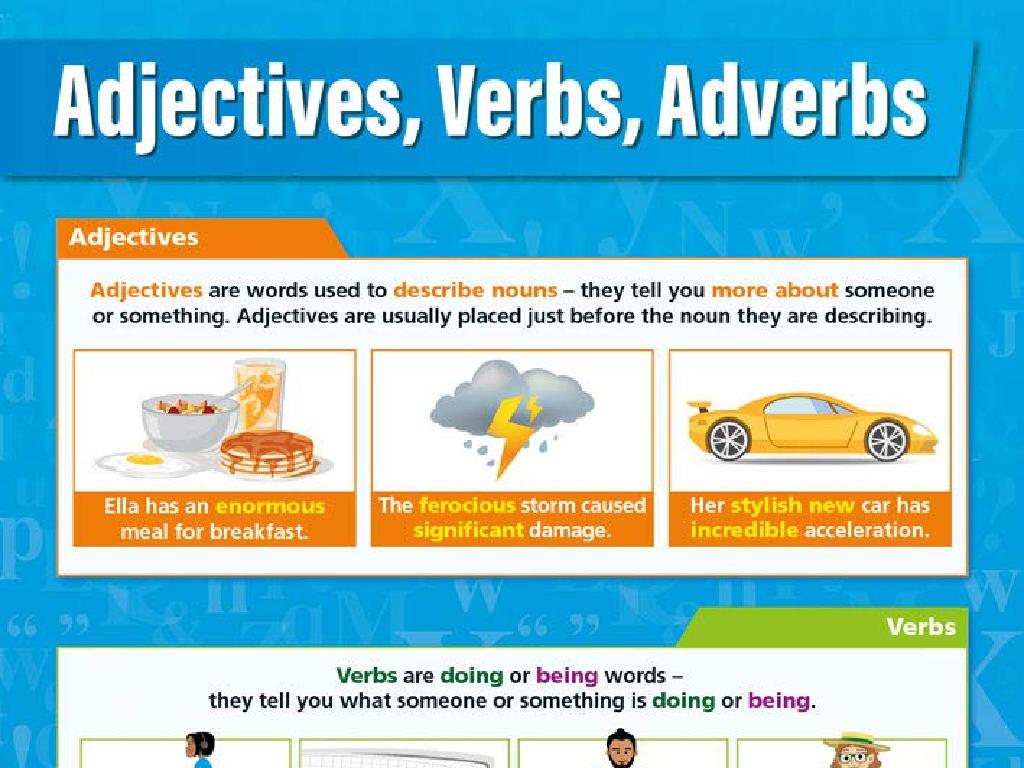Identify Sensory Details
Subject: Language arts
Grade: Fifth grade
Topic: Sensory Details
Please LOG IN to download the presentation. Access is available to registered users only.
View More Content
Welcome to Sensory Details!
– What are sensory details?
– Descriptions that appeal to our senses
– Explore the five senses
– Sight, sound, smell, taste, touch
– Why enrich writing with senses?
– They add depth and allow readers to ‘experience’ the text
– Examples in literature
– ‘The cinnamon buns smelled warm and spicy’ lets us imagine the scent
|
This slide introduces the concept of sensory details and their importance in writing. Sensory details are words or phrases that describe how things look, sound, smell, taste, or feel, and they are used to help the reader visualize or experience the story more vividly. Discuss each of the five senses and how writers use them to bring their writing to life. Explain that by including sensory details, writers can create a rich, immersive experience for their readers. Provide examples from well-known literature where sensory details enhance the narrative. Encourage students to think of their own examples and consider how sensory details can improve their descriptive writing.
Exploring Our Senses
– Five senses: sight, sound, smell, taste, touch
– Examples for each sensory detail
– Sight: a rainbow of colors. Sound: a loud thunderclap. Smell: fresh rain on soil. Taste: the tang of a lemon. Touch: the softness of cotton.
– Senses help us experience the world
– We understand our environment using our senses, like smelling food to enjoy it.
– Engaging senses in descriptive writing
– Use sensory details to make stories come alive for the reader.
|
This slide introduces students to the concept of sensory details and how they relate to the five senses. It’s important to provide clear examples for each sense to help students understand how sensory details can be used in writing to create vivid imagery. Discuss how each sense contributes to our experience of the world around us. Encourage students to think of their own examples and consider how authors use sensory details to enhance their stories. This will prepare them for an activity where they will write descriptive sentences using sensory details.
Exploring Sight: Visual Details in Texts
– Describing colors and shapes
– Use adjectives to describe objects, like ’round, red apple’.
– Painting a picture with words
– Create a vivid mental image for the reader.
– Activity: Image observation
– Look at an image and write down everything you see.
– Discuss visual imagery
– Share how authors use sight to enhance stories.
|
This slide introduces students to the concept of visual details and how they contribute to sensory descriptions in texts. Start by explaining the importance of colors and shapes in building imagery. Encourage students to think about how descriptive words can create a picture in their minds, just like an artist with a canvas. For the activity, present an image and ask students to write down all the visual details they observe. This will help them practice identifying and articulating visual elements. Afterward, facilitate a discussion on how these details can enrich a story, making it more engaging and relatable. The goal is to enhance their descriptive writing skills by using visual details effectively.
Exploring Auditory Details: The Sounds Around Us
– Understanding noises and tones
– Differentiate between loud, soft, high, and low sounds.
– Exploring the sounds of language
– Notice how sounds can create rhythm and mood in poetry and stories.
– Activity: Busy street sounds
– Think about the noises you hear on a street. Cars honking? People talking?
|
This slide aims to teach students about auditory sensory details, focusing on the different types of sounds and how they contribute to our understanding of the world. Begin by discussing the variety of noises and tones they might encounter, such as the difference between a whisper and a shout, or a siren and a song. Highlight how sounds are used in language to convey emotion and rhythm, particularly in poetry. For the activity, encourage students to close their eyes and imagine the sounds they would hear on a busy street, then list them out. This exercise helps students become more aware of the auditory details in their environment and understand how these details can be used in writing to create a vivid picture for the reader.
Exploring Olfactory Details: The Sense of Smell
– Describing different scents
– Think of words to describe smells like ‘fragrant’ or ‘pungent’.
– Smells link to memories
– Discuss how a whiff of cookies might remind you of baking with family.
– Class activity: Home smells
– Share smells from your home and the memories they bring up.
|
This slide focuses on the olfactory aspect of sensory details, encouraging students to explore and describe various scents and aromas. Discuss how certain smells can evoke memories, such as the scent of a perfume reminding someone of a relative or the smell of rain bringing back a specific event. For the activity, ask students to think of smells that they associate with their home and the memories linked to those scents. This will help them understand the powerful connection between our sense of smell and our memories. Encourage them to use descriptive language and be ready to share their thoughts in the next class.
Exploring Taste: Gustatory Details
– Understanding flavors and tastes
– Sweet, sour, salty, bitter, and umami are the five basic tastes.
– Describing food experiences
– Use adjectives to share what eating your favorite meal feels like.
– Activity: Describe your favorite food
– Think about the taste, texture, and how it makes you feel.
|
This slide introduces students to the concept of gustatory details, which are descriptive elements related to taste. Start by explaining the five basic tastes and ask students to think of examples for each. Then, discuss how to describe food experiences using sensory language, focusing on taste and texture. For the activity, students will write a short paragraph about their favorite food, using descriptive language to convey the taste and the emotions it evokes. Teachers should provide guidance on using vivid adjectives and encourage students to share their descriptions in the next class. Possible activities include a taste test, writing a food review, or creating a menu with descriptive language.
Exploring Touch Through Tactile Details
– Understanding textures
– Textures describe how things feel, like rough or smooth.
– Learning about temperatures
– Temperatures can be hot, warm, cool, or cold to the touch.
– The sensation of touch
– Touch is one of our five senses; it helps us feel.
– Class Activity: Puppy Encounter
– Think about how it feels to cuddle a soft, warm puppy.
|
This slide introduces students to the concept of touch as a sensory detail, focusing on textures and temperatures. Explain that tactile details are descriptors related to the sense of touch, such as rough, smooth, sticky, or slippery. Discuss how temperatures add another layer to our sensory experience. For the activity, guide students to imagine holding a puppy, focusing on the soft fur, the warmth, and the gentle weight in their arms. Encourage them to describe the experience using sensory words. For the teacher: Prepare a tactile box with various objects for students to feel and describe. Have students share their descriptions with the class to enhance their understanding of tactile details.
Writing with Sensory Details
– Use sensory details to enhance stories
– Include sights, sounds, smells, tastes, and textures in your writing
– Learn the ‘Show, Don’t Tell’ technique
– Instead of saying ‘it was sunny’, describe how the sun felt on your skin
– Activity: Describe a beach day using senses
– Write a paragraph about the beach, include how the sand felt, the ocean sounded, and the air smelled
|
This slide introduces the concept of sensory details in writing, which are crucial for creating vivid imagery and engaging stories. The ‘Show, Don’t Tell’ technique is a fundamental writing strategy that encourages students to describe experiences and emotions through the senses rather than just stating facts. For the activity, students will write a short paragraph about a day at the beach, focusing on incorporating sensory details that appeal to all five senses. This exercise will help them practice showing rather than telling and enhance their descriptive writing skills. Teachers should provide examples and encourage creativity, reminding students to think about how each sense contributed to their experience at the beach.
Class Activity: Sensory Detail Scavenger Hunt
– Engage in a sensory scavenger hunt
– Find sensory details around you
– Look for things you can see, hear, smell, touch, and taste
– Share your sensory discoveries
– Discuss the details as a class
– Think about how these details help us describe our world
|
This activity is designed to help students identify and understand sensory details through an interactive and fun scavenger hunt in the classroom. Encourage students to use their five senses to find items or elements in the classroom that stand out. They should note how these items look, sound, smell, feel, and even taste if applicable. After the hunt, students will share their findings with the class, fostering a discussion on how sensory details can paint vivid pictures in writing and help bring stories to life. For the teacher: Prepare a list of potential sensory details in the classroom to guide students if they get stuck. Consider having different stations or areas with a variety of textures, scents, and visuals to enrich the experience.
Sensory Details: Enhancing Descriptive Writing
– Recap: Why sensory details matter
– Sensory details add depth to stories, making them feel real.
– Sensory details make writing vivid
– Using the 5 senses helps readers experience the story.
– Homework: Descriptive walk to school
– Include sights, sounds, smells, textures, and tastes from your walk.
|
As we conclude, remind students that sensory details are crucial for creating a rich experience in writing. They allow the reader to see, hear, smell, touch, and taste the world of the story, making it come alive. For homework, students should write about their walk to school, focusing on incorporating sensory details. Encourage them to think about the different senses and describe each one vividly. This exercise will help them practice showing, not just telling, in their writing. Provide examples if necessary, and remind them to use adjectives and adverbs to enhance their descriptions.






